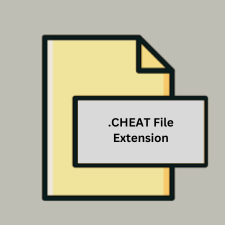.CHEAT File Extension

Navi Cheatsheet
| Developer | denisdoro |
| Popularity | |
| Category | Executable Files |
| Format | .CHEAT |
| Cross Platform | Update Soon |
What is an CHEAT file?
The .CHIP file extension is primarily associated with microarray annotation files used in bioinformatics. Microarray technology is a powerful tool that allows researchers to study gene expression across thousands of genes simultaneously. A .CHIP file contains annotations related to specific microarrays, including information about the genes or probes present on the microarray.
More Information.
Microarray technology revolutionized gene expression studies, allowing researchers to analyze the activity of thousands of genes at once. The .CHIP file was created to accompany microarray data, providing essential annotations that link specific probes on the array to known genes or genomic locations. These files have been widely used in genomic research, particularly in studies involving gene expression profiling, disease research, and drug development.
Origin Of This File.
The .CHIP file format emerged in the early 2000s with the development of microarray technology. This file format was designed to store annotations for microarray experiments, including gene identifiers, probe sequences, and other relevant data. The format was developed by bioinformatics companies and research institutions to standardize the representation of microarray data.
File Structure Technical Specification.
A .CHIP file is typically a plain text file, often formatted as a tab-delimited or comma-separated values (CSV) file.
The file structure usually includes the following columns:
- Probe ID: A unique identifier for each probe on the microarray.
- Gene Symbol: The gene symbol associated with the probe.
- Gene Description: A brief description of the gene or protein.
- Chromosomal Location: The genomic location of the gene.
- Additional Annotations: May include information such as transcript IDs, gene ontology terms, and other relevant data.
How to Convert the File?
Windows
- R with Bioconductor:
- Install R and Bioconductor packages (
readroraffy). - Load the .CHIP file using
read.table()orread.csv(). - Convert to other formats like CSV, TXT, or Excel by writing the data with
write.table()orwrite.csv().
- Install R and Bioconductor packages (
- GenePattern:
- Upload the .CHIP file to GenePattern.
- Use built-in modules to convert the file to formats like GCT, CSV, or TXT.
- Excel:
- Open the .CHIP file in Excel (as a text file).
- Save it as a .CSV or .XLSX file.
Linux
- Command Line Tools:
- Use
awk,sed, orcutto manipulate the .CHIP file and convert it to a CSV or TXT file.
- Use
- R with Bioconductor:
- Similar to Windows, use R and Bioconductor packages to load and convert .CHIP files.
- Python:
- Use
pandasto read the .CHIP file and convert it to CSV or Excel.
- Use
Mac
- R with Bioconductor:
- Install R and Bioconductor packages as on Windows and Linux.
- Convert using the same methods.
- GenePattern:
- Access GenePattern through a web browser, upload the .CHIP file, and convert it to the desired format.
- Excel or Numbers:
- Open the .CHIP file in Excel or Apple Numbers and save it as a .CSV or .XLSX file.
Android
- Cloud-based Tools:
- Upload the .CHIP file to Google Drive.
- Open with Google Sheets and export it as a CSV or Excel file.
- Termux (Linux Environment on Android):
- Install Termux, use command-line tools like
awkor Python withpandasto convert the .CHIP file.
- Install Termux, use command-line tools like
- Text Editors:
- Open the .CHIP file in a text editor, make modifications, and save as a .TXT or .CSV file manually.
iOS
- Cloud-based Tools:
- Use Google Sheets or Microsoft Excel for iOS to open and convert the .CHIP file after uploading it to a cloud service.
- Text Editors:
- Open the .CHIP file in a text editor, then copy-paste the data into a spreadsheet app like Numbers or Excel to save it in a different format.
Other Platforms
- Web-based Tools:
- GenePattern: Accessible through any web browser, this tool allows .CHIP file conversion to other formats like CSV, TXT, or GCT.
- Galaxy: A web-based platform for bioinformatics that supports .CHIP files and offers conversion options.
- Online Converters:
- Some websites offer file conversion services, allowing users to upload .CHIP files and convert them to formats like CSV or Excel.
Advantages And Disadvantages.
Advantages:
- Standardization: Provides a consistent format for annotating microarray data.
- Integration: Easily integrates with bioinformatics tools for data analysis.
- Accessibility: Plain text format makes it easy to open and edit.
Disadvantages:
- Limited Flexibility: The format is relatively simple and may not accommodate complex annotation data.
- Manual Editing: Errors can occur if the file is manually edited.
How to Open CHEAT?
Open In Windows
- R Programming Language with Bioconductor packages: Load .CHIP files using the
read.table()function. - GenePattern: A genomic analysis platform that supports .CHIP files.
- Excel: If the file is in a tabular format, it can be opened as a text file in Excel.
Open In Linux
- R Programming Language with Bioconductor packages: Open and analyze .CHIP files.
- Command Line Tools: Use tools like
awk,sed, orgrepfor quick inspection. - GenePattern: Also available for Linux systems.
Open In MAC
- R Programming Language with Bioconductor packages: Similar to Windows and Linux.
- GenePattern: Supports .CHIP files on macOS.
Open In Android
- Text Editors: Basic inspection can be done using text editors like QuickEdit or Jota+ Text Editor.
- Cloud-based Tools: Access and manipulate .CHIP files using cloud platforms like Google Sheets.
Open In IOS
- Text Editors: Similar to Android, basic viewing can be done using text editors like Textor.
- Cloud-based Tools: Use cloud services like Google Drive for access and conversion.
Open in Others
- Web-based Tools: Platforms like Galaxy or GenePattern offer web-based support for .CHIP files, accessible from any device with a web browser.













